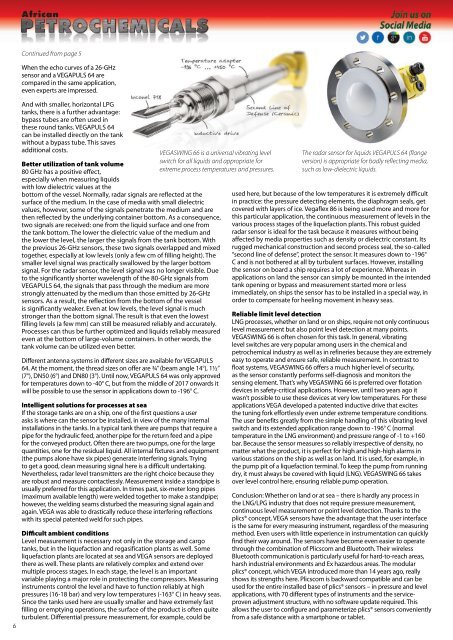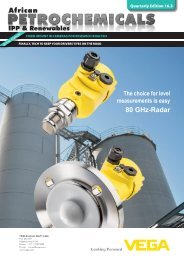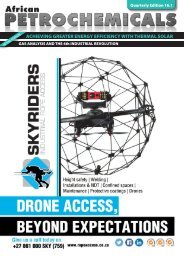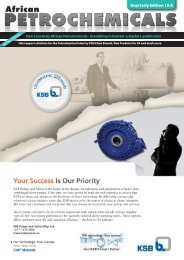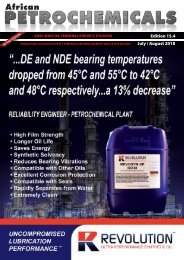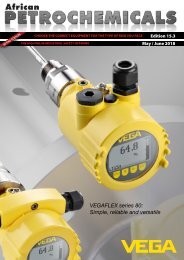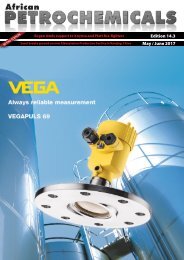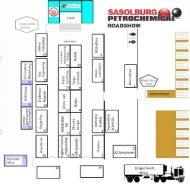African Petrochemicals Jan/Feb Edition 15_1 {2018}
Create successful ePaper yourself
Turn your PDF publications into a flip-book with our unique Google optimized e-Paper software.
6<br />
Continued from page 5<br />
When the echo curves of a 26-GHz<br />
sensor and a VEGAPULS 64 are<br />
compared in the same application,<br />
even experts are impressed.<br />
And with smaller, horizontal LPG<br />
tanks, there is a further advantage:<br />
bypass tubes are often used in<br />
these round tanks. VEGAPULS 64<br />
can be installed directly on the tank<br />
without a bypass tube. This saves<br />
additional costs.<br />
VEGASWING 66 is a universal vibrating level<br />
switch for all liquids and appropriate for<br />
extreme process temperatures and pressures.<br />
Better utilization of tank volume<br />
80 GHz has a positive effect,<br />
especially when measuring liquids<br />
with low dielectric values at the<br />
bottom of the vessel. Normally, radar signals are reflected at the<br />
surface of the medium. In the case of media with small dielectric<br />
values, however, some of the signals penetrate the medium and are<br />
then reflected by the underlying container bottom. As a consequence,<br />
two signals are received: one from the liquid surface and one from<br />
the tank bottom. The lower the dielectric value of the medium and<br />
the lower the level, the larger the signals from the tank bottom. With<br />
the previous 26-GHz sensors, these two signals overlapped and mixed<br />
together, especially at low levels (only a few cm of filling height). The<br />
smaller level signal was practically swallowed by the larger bottom<br />
signal. For the radar sensor, the level signal was no longer visible. Due<br />
to the significantly shorter wavelength of the 80-GHz signals from<br />
VEGAPULS 64, the signals that pass through the medium are more<br />
strongly attenuated by the medium than those emitted by 26-GHz<br />
sensors. As a result, the reflection from the bottom of the vessel<br />
is significantly weaker. Even at low levels, the level signal is much<br />
stronger than the bottom signal. The result is that even the lowest<br />
filling levels (a few mm) can still be measured reliably and accurately.<br />
Processes can thus be further optimized and liquids reliably measured<br />
even at the bottom of large-volume containers. In other words, the<br />
tank volume can be utilized even better.<br />
Different antenna systems in different sizes are available for VEGAPULS<br />
64. At the moment, the thread sizes on offer are ¾” (beam angle 14°), 1½”<br />
(7°), DN50 (6°) and DN80 (3°). Until now, VEGAPULS 64 was only approved<br />
for temperatures down to -40° C, but from the middle of 2017 onwards it<br />
will be possible to use the sensor in applications down to -196° C.<br />
Intelligent solutions for processes at sea<br />
If the storage tanks are on a ship, one of the first questions a user<br />
asks is where can the sensor be installed, in view of the many internal<br />
installations in the tanks. In a typical tank there are pumps that require a<br />
pipe for the hydraulic feed, another pipe for the return feed and a pipe<br />
for the conveyed product. Often there are two pumps, one for the large<br />
quantities, one for the residual liquid. All internal fixtures and equipment<br />
(the pumps alone have six pipes) generate interfering signals. Trying<br />
to get a good, clean measuring signal here is a difficult undertaking.<br />
Nevertheless, radar level transmitters are the right choice because they<br />
are robust and measure contactlessly. Measurement inside a standpipe is<br />
usually preferred for this application. In times past, six-meter long pipes<br />
(maximum available length) were welded together to make a standpipe;<br />
however, the welding seams disturbed the measuring signal again and<br />
again. VEGA was able to drastically reduce these interfering reflections<br />
with its special patented weld for such pipes.<br />
Difficult ambient conditions<br />
Level measurement is necessary not only in the storage and cargo<br />
tanks, but in the liquefaction and regasification plants as well. Some<br />
liquefaction plants are located at sea and VEGA sensors are deployed<br />
there as well. These plants are relatively complex and extend over<br />
multiple process stages. In each stage, the level is an important<br />
variable playing a major role in protecting the compressors. Measuring<br />
instruments control the level and have to function reliably at high<br />
pressures (16-18 bar) and very low temperatures (-163° C) in heavy seas.<br />
Since the tanks used here are usually smaller and have extremely fast<br />
filling or emptying operations, the surface of the product is often quite<br />
turbulent. Differential pressure measurement, for example, could be<br />
The radar sensor for liquids VEGAPULS 64 (flange<br />
version) is appropriate for badly reflecting media,<br />
such as low-dielectric liquids.<br />
used here, but because of the low temperatures it is extremely difficult<br />
in practice: the pressure detecting elements, the diaphragm seals, get<br />
covered with layers of ice. Vegaflex 86 is being used more and more for<br />
this particular application, the continuous measurement of levels in the<br />
various process stages of the liquefaction plants. This robust guided<br />
radar sensor is ideal for the task because it measures without being<br />
affected by media properties such as density or dielectric constant. Its<br />
rugged mechanical construction and second process seal, the so-called<br />
“second line of defense”, protect the sensor. It measures down to -196°<br />
C and is not bothered at all by turbulent surfaces. However, installing<br />
the sensor on board a ship requires a lot of experience. Whereas in<br />
applications on land the sensor can simply be mounted in the intended<br />
tank opening or bypass and measurement started more or less<br />
immediately, on ships the sensor has to be installed in a special way, in<br />
order to compensate for heeling movement in heavy seas.<br />
Reliable limit level detection<br />
LNG processes, whether on land or on ships, require not only continuous<br />
level measurement but also point level detection at many points.<br />
VEGASWING 66 is often chosen for this task. In general, vibrating<br />
level switches are very popular among users in the chemical and<br />
petrochemical industry as well as in refineries because they are extremely<br />
easy to operate and ensure safe, reliable measurement. In contrast to<br />
float systems, VEGASWING 66 offers a much higher level of security,<br />
as the sensor constantly performs self-diagnosis and monitors the<br />
sensing element. That’s why VEGASWING 66 is preferred over flotation<br />
devices in safety-critical applications. However, until two years ago it<br />
wasn’t possible to use these devices at very low temperatures. For these<br />
applications VEGA developed a patented inductive drive that excites<br />
the tuning fork effortlessly even under extreme temperature conditions.<br />
The user benefits greatly from the simple handling of this vibrating level<br />
switch and its extended application range down to -196° C (normal<br />
temperature in the LNG environment) and pressure range of -1 to +160<br />
bar. Because the sensor measures so reliably irrespective of density, no<br />
matter what the product, it is perfect for high and high-high alarms in<br />
various stations on the ship as well as on land. It is used, for example, in<br />
the pump pit of a liquefaction terminal. To keep the pump from running<br />
dry, it must always be covered with liquid (LNG). VEGASWING 66 takes<br />
over level control here, ensuring reliable pump operation.<br />
Conclusion: Whether on land or at sea – there is hardly any process in<br />
the LNG/LPG industry that does not require pressure measurement,<br />
continuous level measurement or point level detection. Thanks to the<br />
plics® concept, VEGA sensors have the advantage that the user interface<br />
is the same for every measuring instrument, regardless of the measuring<br />
method. Even users with little experience in instrumentation can quickly<br />
find their way around. The sensors have become even easier to operate<br />
through the combination of Plicscom and Bluetooth. Their wireless<br />
Bluetooth communication is particularly useful for hard-to-reach areas,<br />
harsh industrial environments and Ex hazardous areas. The modular<br />
plics® concept, which VEGA introduced more than 14 years ago, really<br />
shows its strengths here. Plicscom is backward compatible and can be<br />
used for the entire installed base of plics® sensors – in pressure and level<br />
applications, with 70 different types of instruments and the serviceproven<br />
adjustment structure, with no software update required. This<br />
allows the user to configure and parameterize plics® sensors conveniently<br />
from a safe distance with a smartphone or tablet.


